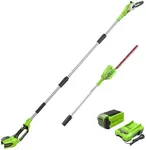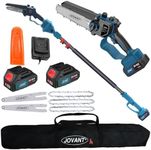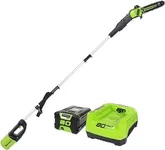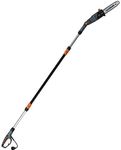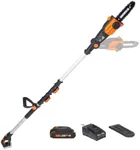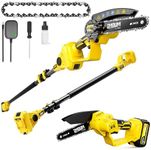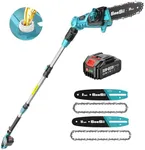Buying Guide for the Best Electric Pole Saws
Choosing the right electric pole saw can make your tree trimming tasks much easier and more efficient. Electric pole saws are designed to help you reach and cut branches that are high up without the need for a ladder. When selecting an electric pole saw, it's important to consider several key specifications to ensure you get the best fit for your needs. Understanding these specs will help you make an informed decision and find a tool that meets your requirements.Power SourceElectric pole saws can be corded or cordless. Corded models need to be plugged into an electrical outlet, which can limit your range but provides consistent power. Cordless models run on batteries, offering more mobility but requiring recharges. If you have a small yard or easy access to power outlets, a corded model might be suitable. For larger areas or more freedom of movement, a cordless model is preferable.
Bar LengthThe bar length of a pole saw determines the maximum diameter of branches it can cut. Common bar lengths range from 6 to 10 inches. A shorter bar length (6-8 inches) is ideal for light trimming and smaller branches, while a longer bar length (8-10 inches) is better for thicker branches and more demanding tasks. Consider the typical size of branches you'll be cutting to choose the appropriate bar length.
Pole LengthPole length affects how high you can reach with the saw. Most electric pole saws have adjustable poles that can extend from around 8 to 15 feet. If you have tall trees or need to reach higher branches, opt for a model with a longer pole. For lower branches or smaller trees, a shorter pole will suffice. Ensure the pole length is manageable and comfortable for you to handle.
WeightThe weight of the pole saw is crucial for ease of use and maneuverability. Lighter models (6-10 pounds) are easier to handle and less tiring, especially for extended use. Heavier models (10-15 pounds) might offer more power but can be more challenging to control. Consider your physical strength and how long you plan to use the saw at a time when choosing the weight.
Cutting SpeedCutting speed, often measured in feet per second (FPS), indicates how quickly the saw can cut through branches. Higher speeds (10-15 FPS) allow for faster cutting, which is beneficial for larger jobs. Lower speeds (5-10 FPS) might be sufficient for occasional or lighter trimming. Think about the frequency and intensity of your trimming tasks to determine the necessary cutting speed.
Ease of UseFeatures that enhance ease of use include ergonomic handles, automatic oiling systems, and tool-less chain tensioning. Ergonomic handles reduce strain and improve comfort, while automatic oiling keeps the chain lubricated without manual intervention. Tool-less chain tensioning allows for quick adjustments. Look for these features if you prioritize convenience and user-friendliness.
Safety FeaturesSafety features such as a safety switch, low kickback chain, and blade guard are important to prevent accidents. A safety switch prevents accidental starts, a low kickback chain reduces the risk of sudden movements, and a blade guard protects the user when the saw is not in use. Prioritize models with these safety features to ensure safe operation.

